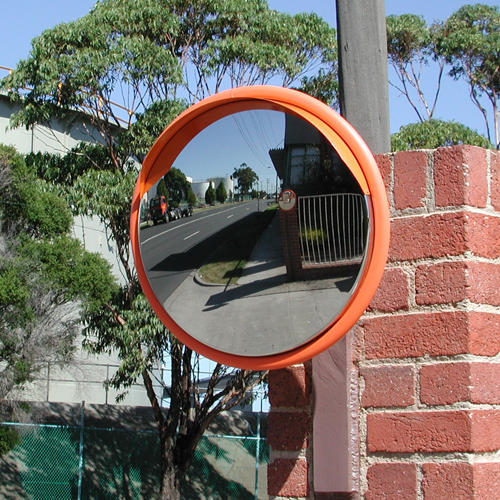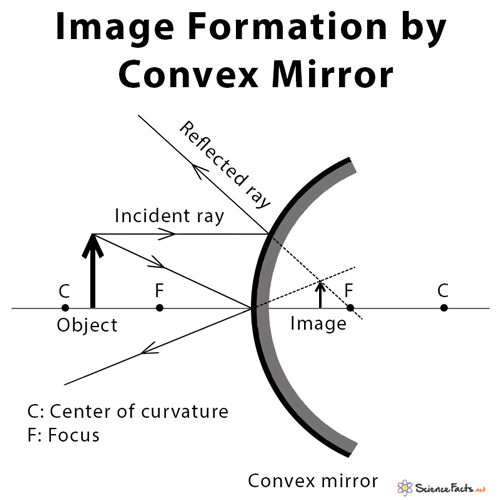Convex Mirror
Definition: What is Convex Mirror?
A convex mirror is a curved mirror that forms a part of a sphere and designed in such a way that light falling on its shiny surface diverges upon reflection. Hence, it is also called a diverging mirror. It cannot be used to produce real images. The image produced by a convex mirror is called a virtual image. It is formed behind the mirror, upright, and diminished but increases in size up to the object size as the object approaches closer to the mirror. This virtual image is created by extending the reflected rays backward.

Ray Diagram for Convex Mirror
Terms Used in Convex Mirror Imaging
- Incident ray – The ray of light that is incident on the surface
- Reflected ray – The ray of light that is reflected from the surface
- Center of curvature – The center of the sphere from which the convex mirror has been constructed
- Radius of curvature – The radius of the sphere from which the convex mirror has been constructed
- Pole – The mid-point of the convex mirror
- Principal axis – An imaginary line that connects the pole and the center of curvature
- Focus – A point on the principal axis where rays of light that are parallel to the axis appear to diverge from
- Focal length – The distance between the pole and the focus and is one-half of the radius of curvature
- Object distance – The distance between the object and the pole
- Image distance – The distance between the image and the pole

Applications of Convex Mirrors
- As side view mirrors in cars, buses, and trucks because the image formed is upright and small thus giving a wide field of view of the area toward the side of and behind the vehicle
- As a security device in supermarkets, grocery stores, and convenient stores since the convex mirror gives a broad view of the area around corners
- At corners on a road so that drivers can see the incoming vehicles and avoid a collision
- As a safety device in warehouses, where workers can see incoming forklifts and vehicles
- As security device in ATM since the user can see the area behind them
- As street light reflectors because the reflected light can spread over a large area
Difference between Convex Mirror and Concave Mirror
Convex Mirror vs. Concave Mirror |
||
| Property | Convex Mirror | Concave Mirror |
| Other names | Diverging mirror, fish-eye mirror | Converging mirror |
| Reflecting surface | Curved outwards | Curved inwards |
| Center of curvature | Lies on the opposite side of the reflecting surface | Lies on the same side of the reflecting surface |
| Focus and focal length | Lies behind the mirror and focal length is negative | Lies in front of the mirror and focal length is positive |
| Image | Virtual, upright, and diminished | Real and inverted, except when the object is placed between the pole and the focus. In that case, the image is virtual, upright, and enlarged. |
| Image size | Smaller than the size of the object | Can be smaller, equal to, and bigger than the object depending on the position of the object |
| Image position | Always within the focus | Can be anywhere on principle axis depending on the position of the object |
| Image projection | Cannot be projected on a screen | Only real image can be projected on a screen |
| Uses and applications | Side view mirrors in vehicles and as security mirrors in grocery stores and supermarkets | Reflecting telescope, headlamp, searchlight, and torchlight |
Article was last reviewed on Tuesday, July 7, 2020







